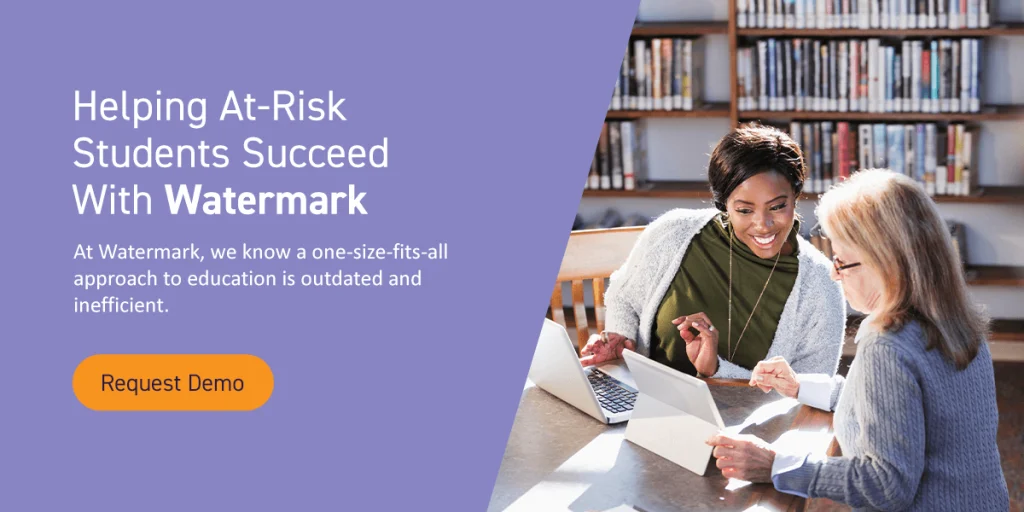At-risk students affect retention rates by dropping out of school or failing courses. Along with disrupting their academic journey, at-risk students can impede the success of other students by being less responsive during group projects or distracting them during class.
Developing effective programs for students at risk can help keep them engaged and ensure they complete their degrees or programs. By identifying at-risk students early, you can give them the support they need to succeed. Discover how to identify at-risk students during the registration process.
What is an at-risk student?
At-risk students are those likely to drop out of school or fail courses. These students enroll in higher education but do not complete their programs or graduate. They may be less responsive in class and attend classes less frequently. These at-risk individuals may also disrupt the ability of other students to learn, or they may neglect coursework and projects.
Sometimes, it can be easy to identify at-risk students. For instance, if a student who typically attends class and performs well suddenly forgets to submit assignments or begins skipping class, instructors may recognize a shift in their performance. Many other students may show less drastic changes while still struggling to overcome barriers.
Characteristics of at-risk students include:
- Receiving low-grade scores
- Missing multiple classes
- Engaging in disruptive behavior
- Neglecting to submit assignments
- Refraining from class participation
- Distracting other students from learning
Many factors can put a student at risk, including homelessness, financial burdens, physical or mental health issues, pregnancy, or domestic violence. Students not equipped for collegiate-level learning may encounter more challenges than others. Without proper resources, these students fall behind and battle to get back on track.
How to identify at-risk students with course registration
Course registration is recurring, making it an excellent source for data collection. Understanding your registration process can help you track student progress. You can see which students are prompt in choosing a course load and who have not signed up for courses. When you identify these students, you can connect with them and ensure they have plans to continue their education at your institution.
Using registration by year
Many institutions offer designated resignation periods, making tracking student completion by grade level easier. Some institutions encourage students who only need one semester of credits to graduate to apply for courses first. Then, students who need just a few more semesters can register next, followed by students who have just completed their first semester. This way, you can observe how many students are registering and when. This system can show whether you’re providing enough resources to assist in registration, potential barriers, and students most susceptible to those barriers.
Consider possible registration barriers and signs of at-risk students by year:
1. First-year students
First-year students may need help understanding where to register for classes and which ones will benefit them most. These students may not understand the importance of timely registration, resulting in classes they want to take filling up before they can get a spot. They may also not know which courses fulfill their program requirements or understand how to build a schedule that sets them up for success.
2. Second-year students
Second-year students may experience some of the same challenges as first-year students, but they also must consider a more defined path. At this point, undecided students should know what major they want to pursue or if they will switch to a different major. If they don’t learn how to complete this process, they may take unnecessary courses or believe they need to leave your institution to pursue other options.
3. Third- and fourth-year students
Third- and fourth-year students should be planning to complete their programs and continue toward success after graduation. These students should be on track to graduate on time and recognize any outstanding requirements they need to complete. Students may need to apply for internships, consider loan repayment plans, and begin the job search.
These obstacles can quickly become barriers for students. Provide your students with the necessary resources to overcome these challenges and keep them on track to graduate. Having a student success center or similar office can give students a point of contact when they’re preparing for registration. Consider implementing a center to aid in internship and job searches, as well. Ensure students know how to connect with these resources and understand the importance of registration.
Considering registration risk indicators
Regardless of their year, students can experience barriers that make it challenging to complete the registration process. Common obstacles can easily become inhibiting if students do not know how to overcome them. Students may not understand how these factors affect their academic standing or program completion.
Registration risk indicators can include:
- Holds
- Undecided majors
- Cumulative GPA
- Residential status
- Unpaid financial balance
- Late fees
- Registered credits
- Midterm grades
- Credit completion

How identifying at-risk students leads to success
Helping at-risk students leads to success by keeping them on track to graduate and ensuring they have the resources they need to succeed. By recognizing which students need assistance, you can connect with them quickly and deliver actionable steps to keep them on track. You can ensure they have a realistic graduation path and continue pursuing an education that aligns with their goals and interests. This holistic approach will further connect them with their studies and enable them to have an active hand in shaping their education.
Identifying at-risk students can also help your institution reach success. You can engage your students and increase retention rates by giving them the resources they need. These benefits can help you define institutional initiatives and set more goals in the future.
How to help at-risk students get back on track
Once you’ve identified an at-risk student, acting quickly and efficiently is essential. Students contemplating dropping out or needing to retake courses may determine they no longer want to pursue education. Without proper guidance, they may fall too far behind to believe they can get back on track.
You can help at-risk students stay on course by:
- Creating a holistic pathway: Every student learns differently and has unique interests. When you make personalized educational plans, students can follow their interests and remain engaged. Some students may benefit from additional practice, while others prefer more accelerated work. Either way, you can help students get the education they’re seeking.
- Fostering positive interactions: Many at-risk students face backlash when they discuss performance. Poor academic performance often leads to punishments, such as probationary periods or being exempt from events. Negative interactions can make at-risk students feel isolated and disconnected from those trying to help them. When you meet with these students, keep a positive tone and discuss the benefits of quality education. These interactions can create a supportive environment where students feel comfortable asking for help.
- Providing plenty of resources: College and university students face numerous challenges that inhibit academic progress. When you understand these obstacles, you can help students find the assistance they need. Beyond writing centers and scheduling help, your institution can offer childcare services, food programs, and housing assistance for students who may need help off-campus.
- Using success coaches and mentors: Provide students with a direct point of contact by using success coaches. These faculty members meet with students, discuss their interests and goals, and provide resources if they fall behind. When you find the right people to become success coaches, they will monitor student progress and keep a collection of intervention strategies, resources, and outcomes that benefit the student.
Helping at-risk students succeed with Watermark
At Watermark, we know a one-size-fits-all approach to education is outdated and inefficient. That’s why we’ve created Student Success & Engagement. This software gives higher ed institutions a way to easily connect with students from the beginning of their educational journey, ensuring they receive the support they need from day one.
With our software, you can monitor attendance, track progress, and turn insights into actionable steps to ensure every student stays on the path to graduation. You’ll receive alerts when a student is falling off track so you know when to connect with them to give support. Request a demo of Student Success & Engagement to create a holistic experience for your students that aligns with their interests and keeps them engaged.
















































































































































































































































































































































































































